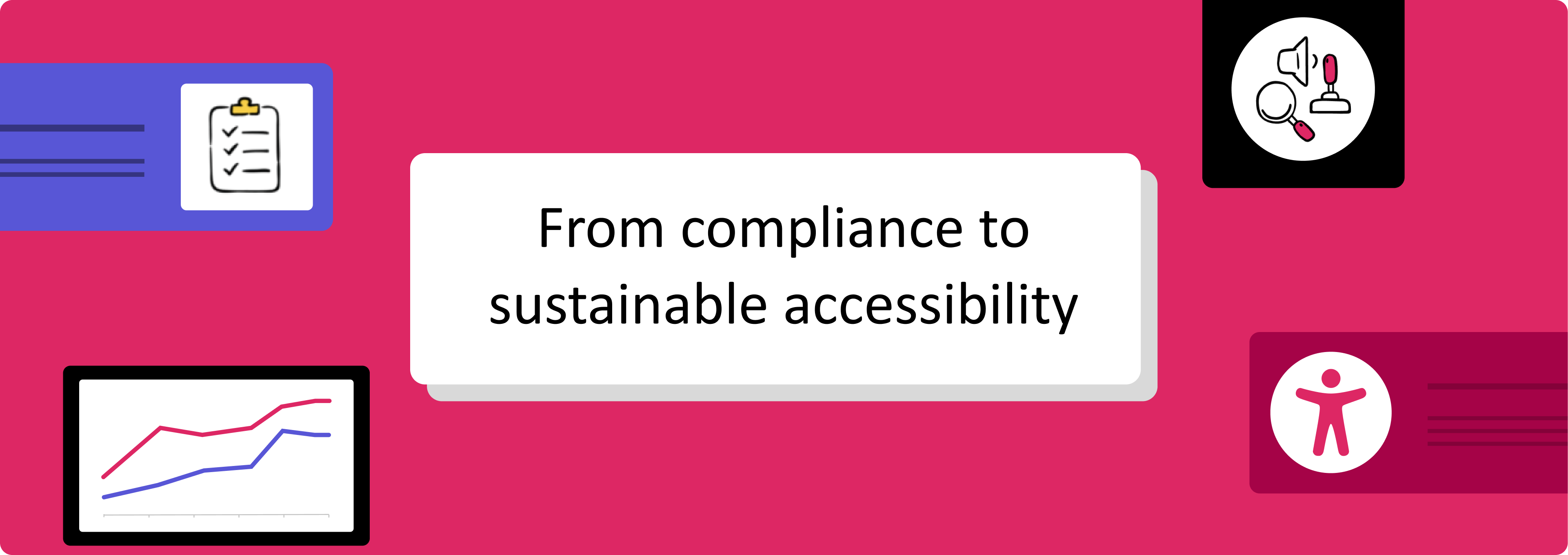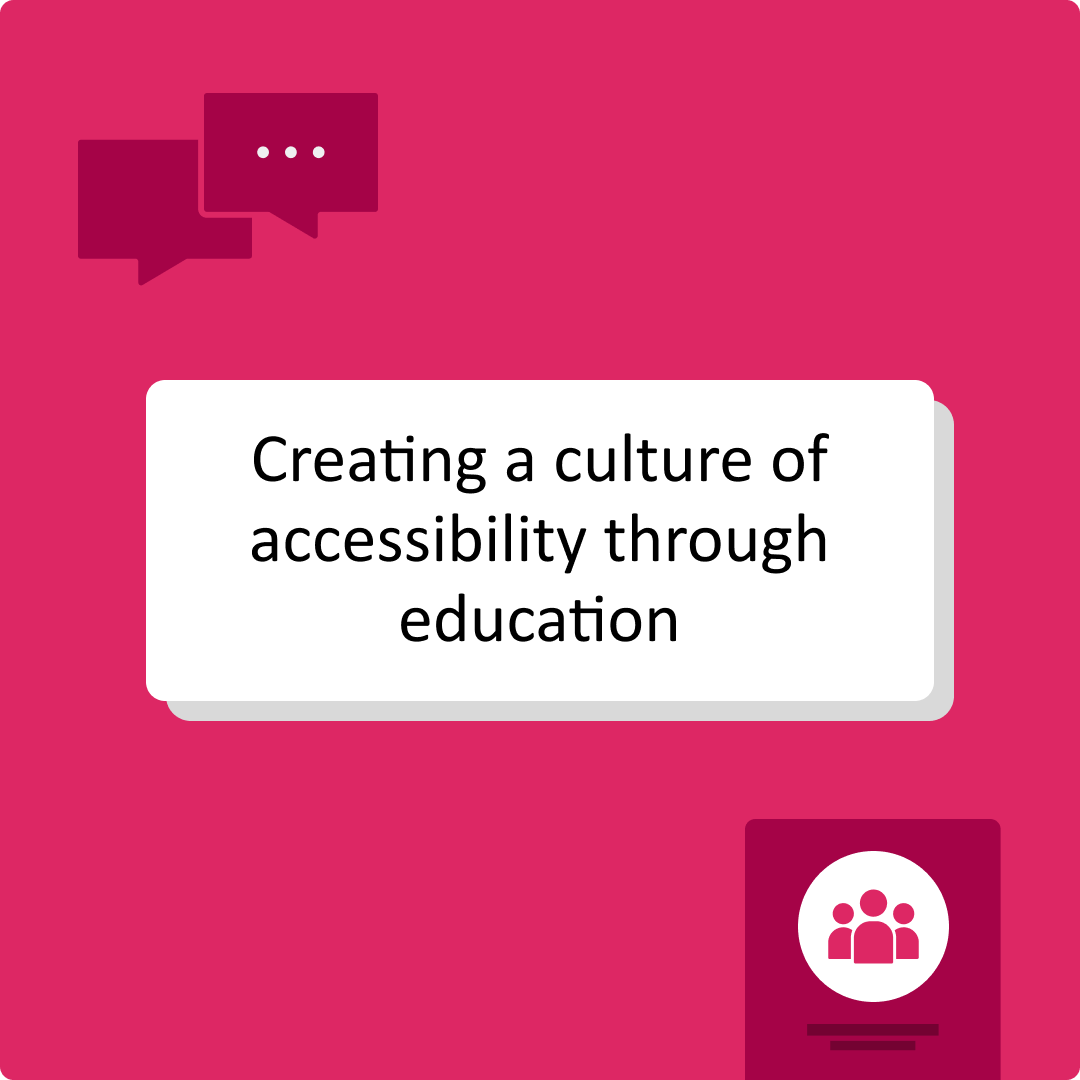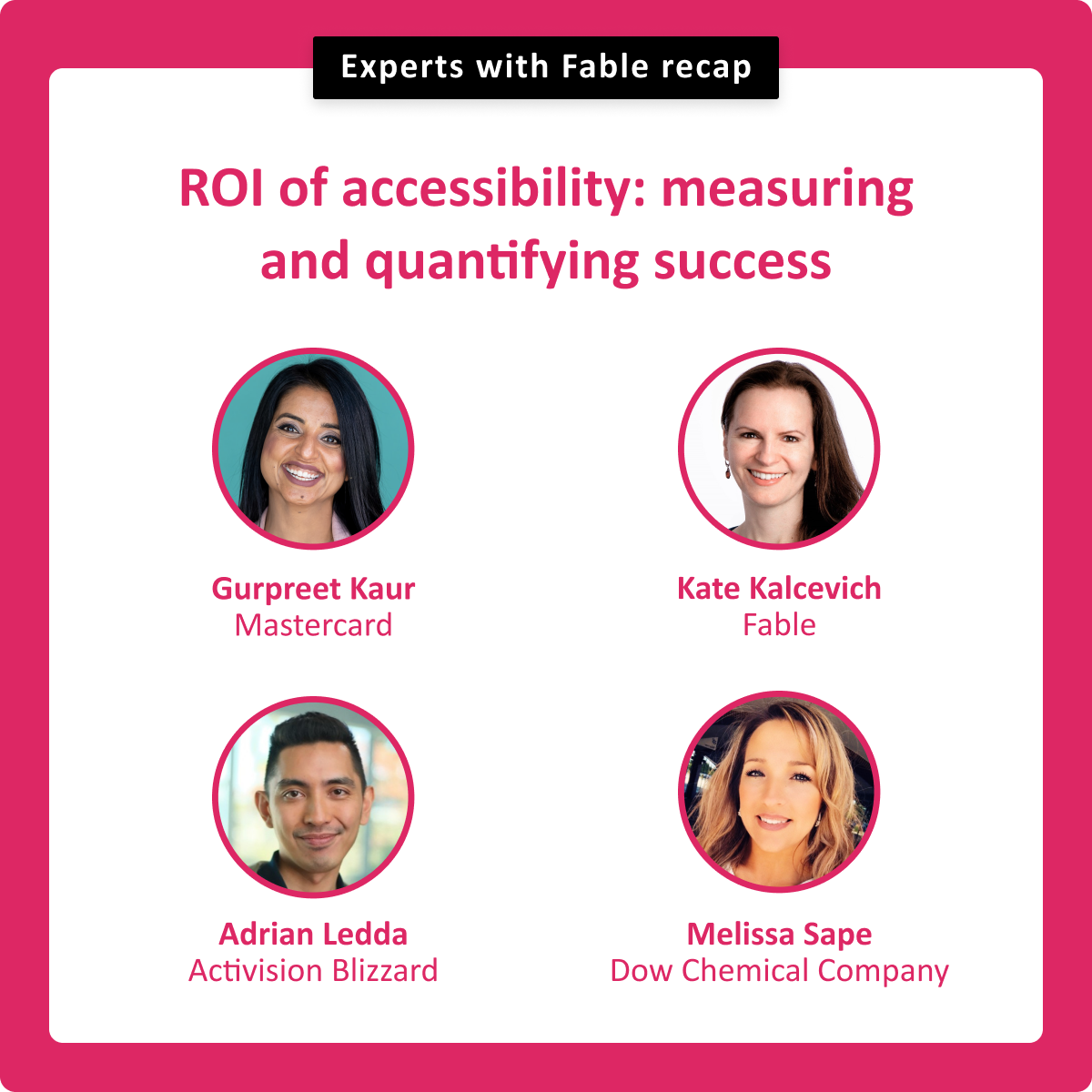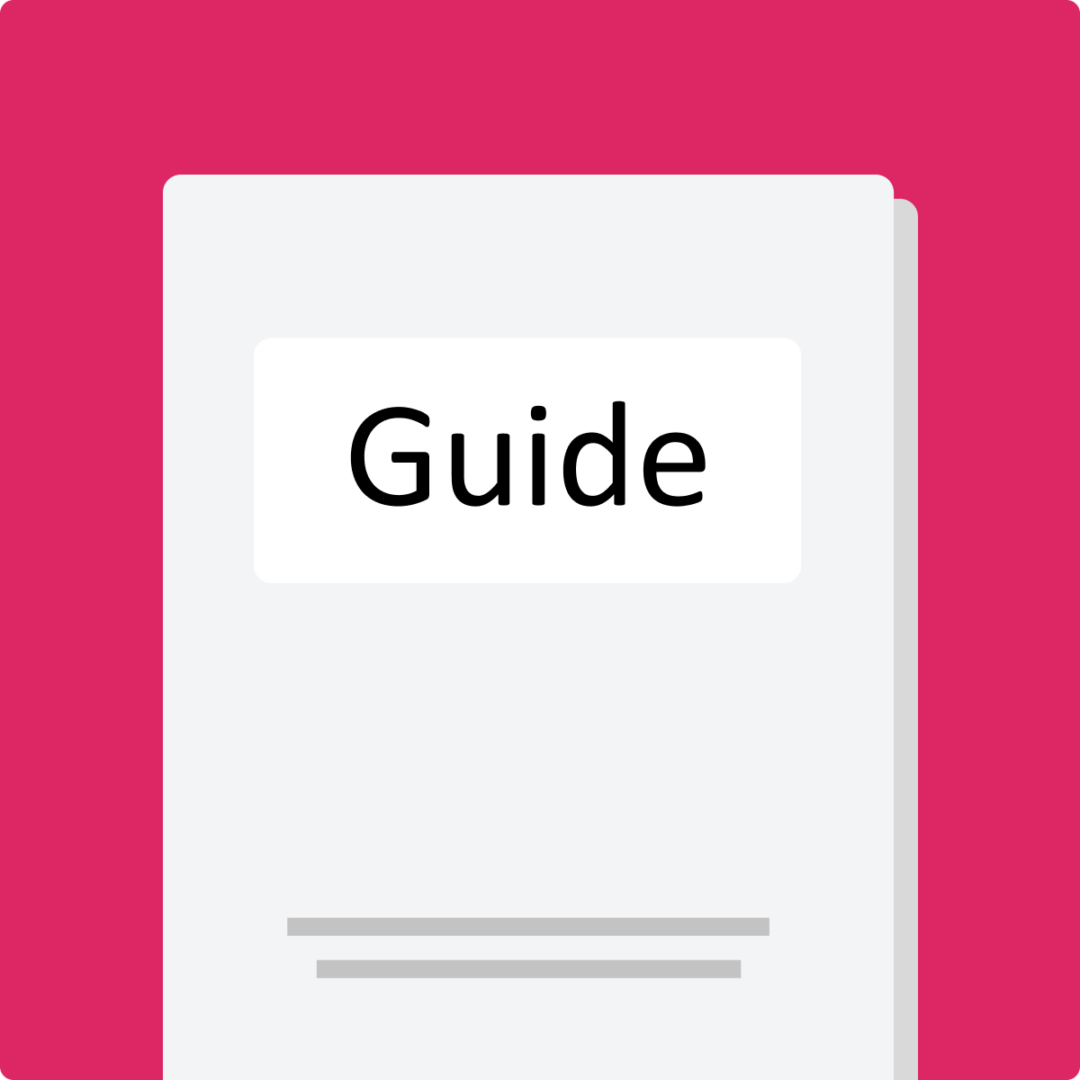
From compliance to sustainable accessibility
Today, many organizations have adopted compliance standards, such as the Americans with Disabilities Act (ADA), the Web Content Accessibility Guidelines (WCAG), and more recently the European Accessibility Act (EAA). At their core, these regulations have a similar goal of ensuring people with disabilities have equitable access to products and services. At Fable, we believe that accessibility is not just focused on people with disabilities having access to the digital world. It’s about people with disabilities being able to fully participate as producers, contributors, and consumers.
While adhering to regulations is an important step, we help organizations go beyond checkbox exercises and focus on fostering sustainable accessibility that genuinely enhances experiences for everyone.
In this article we’ll cover how to work towards compliance goals, while also ensuring your organization is set up for long-term success, including future-proofing against changing regulations. For the purpose of this article, we’ll reference the EAA, but this framework can be applied to other regulations as well.
Understand what’s in scope for regulations
While compliance helps avoid legal ramifications, sustainable accessibility sets your organization up for a long-term commitment to inclusion. Regardless of which path you’re on, understanding what is legally required of your organization is a critical first step. This will help you factor in and plan for areas like budget, headcount and vendor needs.
Since many regulations, including the EAA, affect businesses across different industries, products, and services, it’s critical to seek legal advice. This will ensure you understand requirements based on your organization’s specific operations, as well as known exceptions or national level considerations. The European Accessibility Act (EAA), for example, is aimed at improving the accessibility of a wide range of products and services including e-commerce, banking, telecommunication services, and more. Knowing what is applicable to your organization at the very minimum will help your team prioritize time and resources accordingly. If you’re looking to go beyond compliance, this doesn’t mean you won’t address areas that are out of scope down the line or in parallel, but it will help you focus your immediate efforts.
Evaluate current state of accessibility
Once you’ve aligned on what is in scope for your organization, you’ll want to get a sense for the current state of accessibility for these areas by capturing a baseline. Depending on your priorities, you may choose to evaluate by product, platform or even individual task flow. This process will also help set your organization up to be able to track progress over time and show tangible improvements through benchmarking. (Tip: Benchmarking works best if you first address the accessibility issues you find. We suggest you fix at least 80% of high severity issues before repeating any benchmarking efforts.)
Fable Engage provides two primary ways to measure accessibility through the experiences of assistive technology users:
- Accessible Usability Scale scores
- Task completion rates
When deciding which to use, think about the metrics that your organization currently tracks on a regular basis. Aligning your accessibility metrics to other business metrics will help you show impact in a way that you know leadership cares about.
Establish a plan to fix known issues
Once you have evaluated your priority areas, it’s time to get to work! Don’t be discouraged if your baseline results are not what you hoped for. After all, working on accessibility is about progress, not perfection. At this stage, prioritization will be critical. Regardless of your results, you won’t be able to fix everything at once. Creating a plan to address the issues you uncovered will take time, planning, and patience.
When prioritizing what you will address first, you can consider factors like:
- Severity of issues: Did the issue slow a user down or block them entirely?
- Dissatisfaction: Did users express frustration or abandon a task altogether?
- Frequency: How often would a user encounter this issue?
- Quantitative data: How were task completion rates or volume of issues?
- Existing prioritization matrices: How do you assign priority to other types of user feedback?
Once you’ve created a plan to fix the issues you’ve uncovered, sharing your plan (or aspects of it) on your accessibility statement is a great way to build trust and transparency with your customers, as well as manage expectations. If you are aware of high impact issues, you will save a customer a lot of time and frustration by sharing that in advance, along with available workarounds, while you work to resolve it.
Implement a way to monitor and track accessibility over time
Fixing known issues is important, but to ensure that you are not continuing to introduce accessibility issues in the future, you’ll want to evaluate how your teams are currently building products in addition to how accessible they are today.
It’s important to find ways to measure your organization’s efforts and progress in a way that is both meaningful and achievable. The tools you use to monitor, and metrics you choose to measure, will differ from organization to organization. That said, when going beyond compliance, you’ll want to consider factors beyond just the product level. You’ll want to consider factors like how your teams work, the skills and resources that they have access to, as well as the products they are building or maintaining.
By adopting metrics that encompass people, processes, and products, you can shift towards an outcome-focused approach to accessibility. Fable’s KPI framework offers a practical way for teams to report on accessibility progress. These data points can be easily communicated to senior leadership, sidestepping the complexity and resource demands of measuring accessibility using the Web Content Accessibility Guidelines (WCAG).
Introduce ongoing and role-specific training
Implementing accessibility training for your organization presents an exciting opportunity to advance your practice on a larger scale. While existing accessibility champions and experts offer invaluable expertise, effectively sharing this knowledge and training individual teams can be challenging.
Factors like employee turnover, changing accessibility standards and remote work can make ad hoc accessibility training difficult and diminish the longstanding impact. Instead, Fable Upskill helps to create a culture of accessibility through education through asynchronous, custom, and role-specific training.
By providing ongoing access to accessibility training, you’ll ensure that your teams are always empowered to fix accessibility issues with confidence, while also decreasing the volume of net-new accessibility issues in the future.
Practice inclusive product development
Once you have a plan in place to fix known issues and you’ve identified training needs, it’s critical to think about your product development lifecycle as a whole and where accessibility fits in. To build truly inclusive products you need to incorporate the voices of people with disabilities at every stage, versus only at the end (before you ship a feature or product). Fable’s guide to inclusive product development can help your teams envision what this looks like in practice.
Feedback from assistive technology users should be an ongoing source of knowledge and inspiration for your teams, guiding the way they design, build, and deliver products. In return, you’ll find your teams will be creating delightful experiences for all. Regardless of where you’re starting from, this shift to inclusive product development will take time.
Enjoy the journey
Ultimately, moving beyond compliance toward sustainable accessibility brings countless long-term benefits. Organizations that commit to this approach can expect higher levels of customer satisfaction, better employee engagement, and of course, more inclusive products and services. Accessibility can quickly become a competitive advantage rather than an obligation. You’ll unlock new ways of thinking, build higher quality products, and encourage innovation in a rapidly evolving world.
“Compliance doesn’t unlock opportunities. You need a bigger vision of serving users’ needs through products and services.”
Abid Virani, COO and Co-founder of Fable




